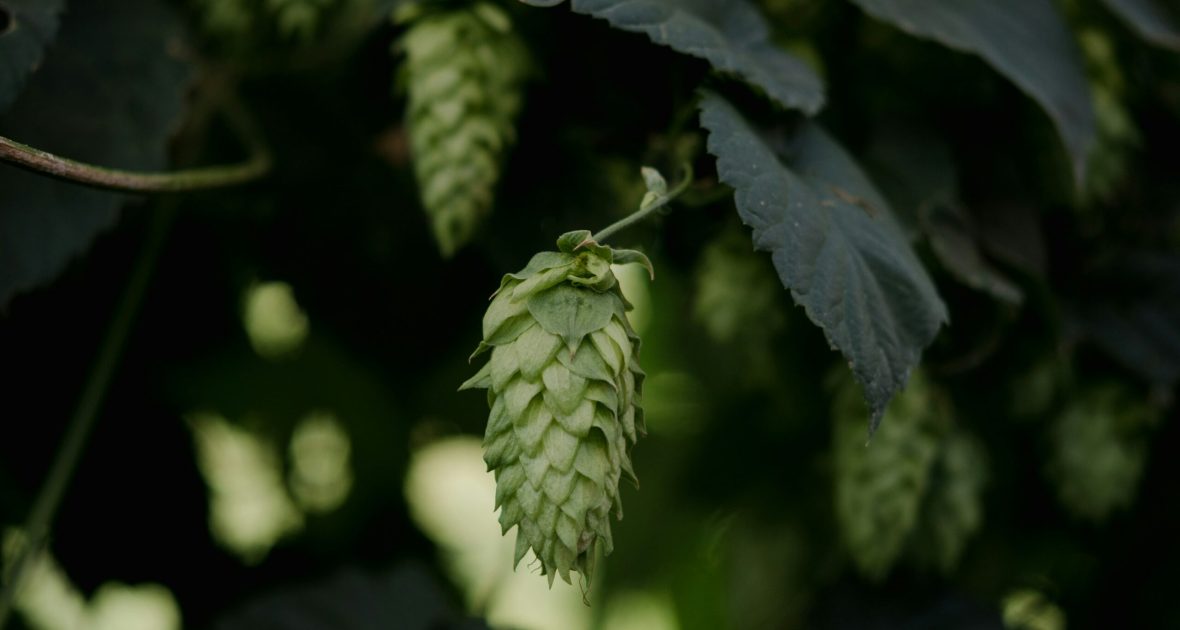
Bennett Porter
Bennett (he/him) is is our Spirits Buyer, is a Certified Cicerone® and holds his WSET Level 3 Certification in Wines. You’ll often see him lurking about the German pilsner and kölsch sections. He also enjoys Steel Toe, Odell, and La Croix and chocolate milk on occasion. If he wasn’t at France 44, he’d be trying to make it work as a full-time snowboard bum. He and his wife share a great Anatolian Shepherd named Bear.
The proliferation of craft beer has drawn an ever closer focus on the importance of hop selection, for both the consumer and the brewer.
Hops are an essential ingredient in brewing: providing bitterness, aroma, flavor, foam stabilization and a natural preservative with their antimicrobial qualities.
To the educated consumer, hop varieties listed on a beer label can offer an indication of the flavor and aroma characteristics to expect.
That said, the same hop variety can show differently when used in a pilsner versus an IPA versus an Imperial Stout. Just as a chardonnay aged in oak barrels differs hugely from a young chardonnay, aged in stainless steel, the way that hops are used in brewing will have a huge outcome on the finished product. It’s as much about the method and brewing technique as it is about the hops. Lighter and hop-forward beer styles will naturally showcase more of a hop variety’s characteristics than stronger, darker styles.
What Exactly Are Hops?
Hops (humulus lupulus) are a species of perennial flowering bine from the hemp family Cannabaceae. Though used interchangeably, hops are considered a bine not a vine, as their flexible shoots wrap around their support, whereas vines use tendrils to secure themselves and do not twist.
The plant is dioecious, meaning male and female plants are separate. It is only the female flower cones that are known as hops. Hop cones contain lupulin glands at the base of their petals that house essential oils, resins and terpenes. These are the components that provide the bitterness, aroma and flavor to beer.
Hop varieties can be grouped into three types:
- Bittering hops: The high alpha acid content in these varieties gives greater bittering potential. More bitterness is extracted the earlier they are added in the boiling process.
- Aroma hops: These hops contain more volatile oils and terpenes that can contribute a bouquet of aromas and flavors in the finished beer. Aroma hops are added later in the boil or during fermentation to not boil off their distinct qualities.
- Dual-purpose hops: These hop varieties offer great flexibility to the brewer. Their high alpha and oil content can provide both bittering and aroma potential.
The characteristics that determine which category a hop falls into are strongly influenced by origin and lineage. Traditional European hop varieties impart a delicate and mild character into the finished brew, effusing floral, earthy and spicy aromatics. Their lower alpha acid content lends a finer, crisp sort of bitterness. American hops are bold by contrast, with more pronounced and varied aromas of citrus, pine and tropical fruits. Their generally higher alpha acid content can impart a strong, lingering bitterness that is key to many American beer styles. The difference between European and American hops is best reflected in the styles brewed there. Even a mild American style such as Amber Ale is noticeably more hoppy than most imported lagers and ales.
That being said, more isn’t always better! The key is to understand what you like and why, making it easier to select the next brews for your fridge.
Now that we have a general outline of hops and their usage, listed below is a few of our favorite hop varieties and familiar beers made with them:
- Saaz (Žatec, Czechia – Aroma hop): One of the four original noble hops, Saaz is used prominently in Bohemian pilsner and lager styles. Its high farnesene content gives off a woodsy, herbal, sometimes green apple-like quality and low alpha acid content can add a soft bitterness when used early in the boil.
- Hallertau (Bavaria, Germany – Aroma hop): Another noble hop variety, whose cultivation dates back to the Middle Ages. It is arguably the “classic” German hop, with clean floral aromas of sage, rosemary, lavender and pine thanks to higher humulene content. Perfect for pilsners and other lager styles.
- Strisselspalt (Alsace, France – Aroma hop): Low in alpha acid with a pleasing herbal, spicy quality with hints of citrus from higher percentage of myrcene
- Citra® (Yakima, Washington – Aroma/Dual-Purpose hop) Arguably the superstar of American hops, Citra® bursts with lime, grapefruit and tropical aromas. Its high alpha acid content can produce a harsh bitterness, so it must be used judiciously.
- Mosaic® (Yakima, Washington – Dual-Purpose hop) Just ever-so-slightly in the shadow of Citra® hops, Mosaic is equally beloved by American craft brewers. Featuring aromas of mango, pine, citrus and berry with a pleasing bitterness, this hop can do it all. It is often featured alongside Citra® as they play well together.
- Warrior® (Yakima Valley, Washington – Bittering hop) This high alpha hop is perfect for adding a clean bitterness to brews, with hints of citrus and spice.
- Nelson Sauvin (New Zealand – Dual-Purpose hop) Named after the Sauvignon Blanc wine grape, with whom it shares many characteristics. Notes of gooseberry and white wine grape, it can impart a smooth bitterness.
- Modist Foeder 44 Dry-Hopped Pilsner, plus many limited release IPAs and Pale Ales (keep your eyes peeled!)
